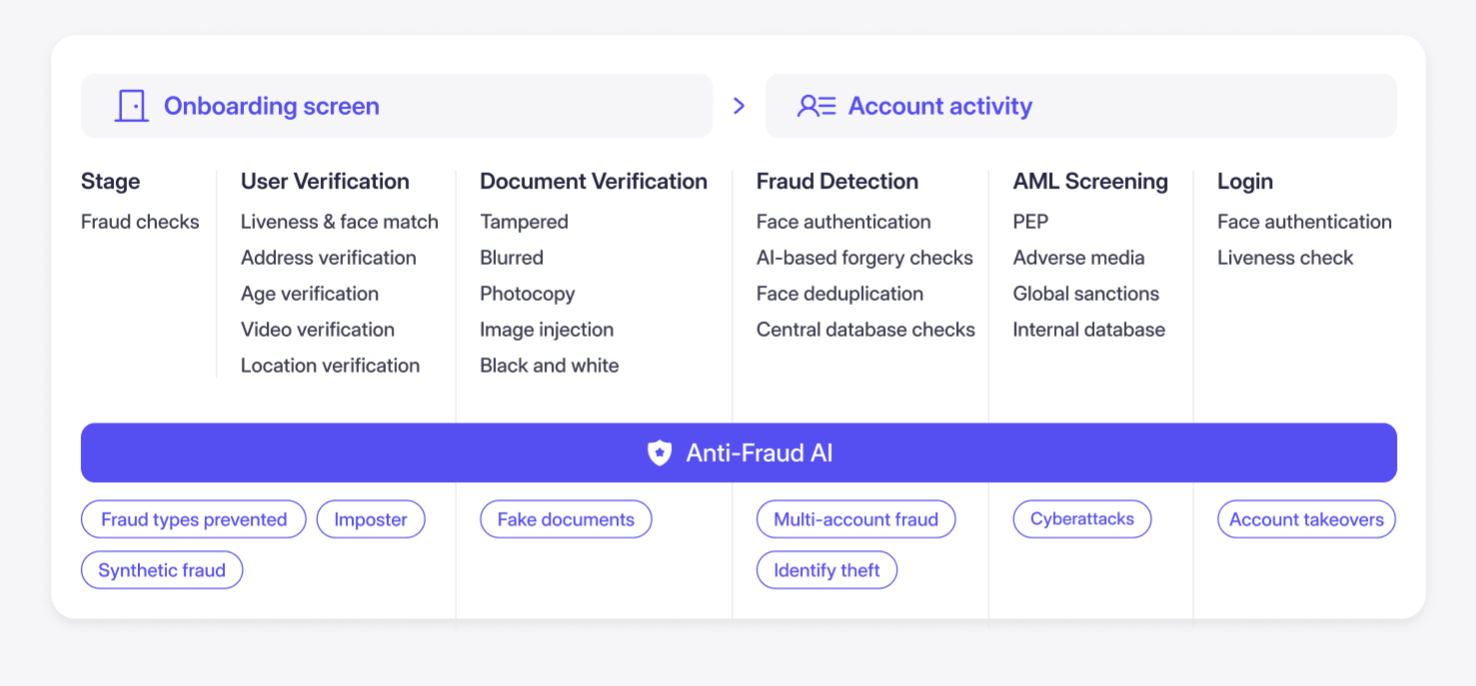Various types of fraud, such as identity fraud, are a constant concern for businesses today. Alongside identity fraud, the prevalence of payment fraud significantly impacts industries, urging the need for effective fraud management tools.
Fraud detection tools play an important role in helping businesses prevent fraud by detecting, preventing, and mitigating fraudulent activities.
But with so many fraud detection solutions out there, finding the right one can be difficult. In this post, we’ll help you choose the best purchasing fraud detection software tool for your business.
What is a fraud detection solution?
Fraud Detection Tools are software solutions designed to identify, prevent, and mitigate fraudulent activities. They use advanced algorithms and machine learning to detect suspicious patterns and fraudulent behavior, applying the basic risk rule to block or flag suspicious activities, such as login attempts from risky IP addresses.
These fraud software tools are essential for safeguarding against various types of fraud, such as identity theft, account takeover, transaction fraud, and application fraud.
Fraud detection tools provide businesses with several advantages. They efficiently identify and prevent fraudulent activities, resulting in reduced financial losses. By detecting fraud, these tools help maintain customer trust and satisfaction.
Additionally, they ensure regulatory compliance with standards like PCI-DSS and GDPR. Moreover, businesses benefit from improved decision-making and enhanced brand reputation. Cost savings are also discovered through the prevention of fraud, chargebacks, and refunds.
Top Features of Fraud Detection Solution
Here are some features you can consider before selecting fraud detection software:
By focusing on fraud management tools and fraud detection software that incorporate automatic fraud detection capabilities, businesses can significantly enhance their ability to detect, prevent, and mitigate various forms of fraudulent activities, including payment fraud, chargebacks, identity fraud, and account takeover fraud.
This comprehensive approach to fraud prevention is crucial for safeguarding against the financial and reputational damage caused by such activities.
Identity Verification
Identity verification is important in fraud detection for organizations. By confirming the identity of individuals involved in transactions or accessing sensitive information, it significantly reduces the risk of fraudulent activities. This process helps prevent account takeover, detects identity theft early on, and enhances transaction security.
Moreover, identity verification ensures compliance with regulations like KYC and AML laws and reduces the possibility of fraudulent applications. By implementing robust identity verification measures, organizations strengthen customer trust and prove their commitment to security.
Real-time transaction monitoring
Real-time transaction monitoring is important for detecting fraudulent patterns and anomalies in transaction data. By using historical business data using advanced analytical tools and algorithms, financial institutions can identify fraud and scams as they occur, preventing money from leaving victims’ accounts.
This assertive approach allows fast intervention, minimizing financial losses and safeguarding customers against fraudulent activities.
Risk assessment and management
Risk assessment and risk management also are necessary when selecting fraud detection software. Organizations can prioritize features and functionalities by understanding their specific fraud risks and needs. This ensures they choose a solution that provides adequate protection and mitigation capabilities according to their unique requirements.
AI/ML capabilities and level of automation
When choosing fraud detection software, it’s important to evaluate AI/ML capabilities and automation levels. These features improve accuracy, promote real-time monitoring, and streamline processes for effective fraud detection and prevention. AI boosts operational efficiency, reduces false positives, and adapts to developing fraud patterns, enhancing overall effectiveness in combating fraud at scale.
Behavioral and transaction analytics
When selecting fraud detection software, prioritize robust behavioral and transactional analytics solutions. These capabilities enable the anomaly detection software to detect anomalies indicative of fraud, enhancing its effectiveness in prevention. Prioritizing solutions with behavioral analytics helps flag unusual behavior for investigation, improving overall fraud detection accuracy.
Deduplication
Deduplication is important when choosing fraud detection software as it ensures accuracy by removing duplicate data, improving the effectiveness of identifying fraudulent activities.
Top 6 fraud detection solutions
Here are the Top 6 Fraud Detection Software:
1. HyperVerge
HyperVerge Identity Verification simplifies the digital identity verification process, ensuring instant confirmation of customers’ identities across 195+ countries. By leveraging an end-to-end platform, businesses can streamline onboarding processes while maintaining compliance standards.
Key features of the solution include:
- Dedupe: HyperVerge’s Dedupe solution ensures data accuracy by identifying and removing duplicate entries. By streamlining data processing, it enhances the efficacy of fraud detection efforts.
- AML: HyperVerge’s AML solution aids in regulatory compliance and prevents financial crimes. By analyzing transactional data, it identifies suspicious activities and effectively mitigates associated risks.
- Deepfake: HyperVerge’s deepfake detection solution addresses the growing threat of manipulated media. Detecting deepfakes in images and videos safeguards against identity theft and misinformation campaigns.

Moreover, HyperVerge’s platform stands out with its complete, end-to-end solution, allowing businesses to verify identities across the globe instantly. Unlike others that depend on third-party AI technology, HyperVerge’s proprietary AI enables fast innovation and customization to address evolving needs.
With HyperVerge Identity Verification, businesses can streamline processes, enhance security, and expand globally with ease. Discover how HyperVerge’s solutions for verifying identity online can simplify and secure your digital processes. Get a customized demo today.
2. SEON
SEON is a well-known player in the fraud detection space. It is a solution for businesses of all sizes. Its features include thorough device fingerprinting for detailed user profiles, comprehensive data enrichment based on email, IP, or phone number, and access to over 90 social and digital profiles to unveil customers’ true intentions.
SEON offers fraud prevention tools, including device fingerprinting, whitebox machine learning, custom risk rules synthetic identity fraud against, and AML monitoring. While providing a free license option, it lacks on-site integration and identity document verification (IDV) checks. Nonetheless, SEON’s solutions remain a powerful asset for businesses combating fraud.
3. ComplyAdvantage
While ComplyAdvantage is good in Anti-Money Laundering (AML) efforts, it is also helpful in reducing fraud rates associated with money laundering. Their suite of solutions encloses transaction monitoring, customer screening against sanction lists and PEP lists, fraud protection software, and checks aligned with the Financial Action Task Force to monitor adverse media.
ComplyAdvantage provides easy API integration and offers a free version for startups. However, its focus on compliance limits features like data enrichment and digital footprint analysis for its fraud detection models.
4. Sift
Sift’s flagship offering, the Digital and Safety Suite, integrates various API tools into a comprehensive solution. Additionally, it features a specialized module dedicated to user authentication and prevention of account takeover (ATO) attacks, with the capability to enable two-factor authentication (2FA) simultaneously.
Sift serves enterprises with notable features, such as the chargeback resolution module and content security add-on. However, its blackbox artificial intelligence (AI) approach may lack transparency for some users. Additionally, Sift lacks real-time social media checks and AML checks, which may limit its effectiveness in certain fraud prevention scenarios.
5. Kount
Kount handles compliance challenges by integrating a global watchlist screening module and providing a tool to streamline mandated regulatory reporting processes for high-risk customers and transactions. Kount’s focus on retail e-commerce allows service providers and merchants in diverse sectors, including streaming services and dating apps, to protect their revenues against fraud and chargebacks.
With its flexible tools, Kount helps different industries, from regulated sectors to top e-commerce brands. It offers automated rules for preventing chargebacks and simplifying manual reviews. However, some users have noted limited machine learning capabilities to newer solutions. Also, data enrichment may affect the effectiveness of the fraud prevention solution.
6. Signifyd
Signifyd is a provider of fraud prevention solutions for enterprise e-commerce clients. With a focus on protecting online stores globally, Signifyd offers a suite of products designed to prevent chargebacks efficiently. Kount’s solutions are designed for handling high transaction volumes and feature automated chargeback prevention, providing merchants with peace of mind.
Despite some limitations, such as the absence of real-time data, Signifyd’s commitment to PSD2 compliance and innovative chargeback-guarantee model make it a trusted partner in the fight against fraud.
Choose the best fraud detection software
Before selecting a fraud detection software solution, it’s important to consider your business or organization’s specific needs. Clarifying these requirements is essential to finding the right fit among the numerous available options.
By understanding your unique challenges and objectives, you can ensure that the chosen solution aligns closely with your priorities, maximizing its effectiveness in combating fraud.
HyperVerge offers identity verification solutions essential for fraud detection, ensuring compliance, and bolstering transaction security. Its real-time monitoring, AI capabilities, and behavioral analytics enhance accuracy, detect fraudulent activities, and enable proactive fraud prevention.
Additionally, HyperVerge’s deduplication feature ensures data accuracy, improving effectiveness in identifying fraudulent activities.
Learn more about HyperVerge’s identity verification solutions and enhance your fraud prevention account protection strategy. Ready to safeguard your business from fraud? Sign Up now.





